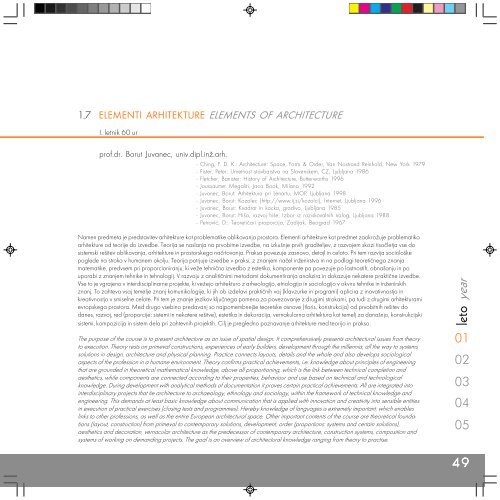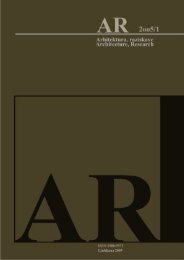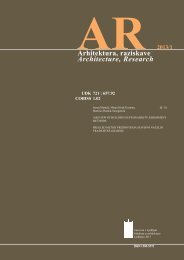VeÄ - Fakulteta za arhitekturo - Univerza v Ljubljani
VeÄ - Fakulteta za arhitekturo - Univerza v Ljubljani
VeÄ - Fakulteta za arhitekturo - Univerza v Ljubljani
Create successful ePaper yourself
Turn your PDF publications into a flip-book with our unique Google optimized e-Paper software.
1.7 ELEMENTI ARHITEKTURE ELEMENTS OF ARCHITECTURE<br />
I. letnik 60 ur<br />
prof.dr. Borut Juvanec, univ.dipl.inž.arh.<br />
- Ching, F. D. K.: Architecture: Space, Form & Order, Van Nostrand Reinhold, New York 1979<br />
- Fister, Peter: Umetnost stavbarstva na Slovenskem, CZ, Ljubljana 1986<br />
- Fletcher, Banister: History of Architecture, Butterworths 1996<br />
- Joussaume: Megaliti, Jaca Book, Milano 1992<br />
- Juvanec, Borut: Arhitektura pri Lenartu, MOP, Ljubljana 1998<br />
- Juvanec, Borut: Kozolec (http://www.ij.si/kozolci), Internet, Ljubljana 1996<br />
- Juvanec, Borut: Kvadrat in kocka, gradivo, Ljubljana 1985<br />
- Juvanec, Borut: Hiša, razvoj hiše, Izbor iz raziskovalnih nalog, Ljubljana 1988<br />
- Petroviæ, D.: Teoretièari proporcija, Zodijak, Beograd 1967<br />
Namen predmeta je predstavitev arhitekture kot problematike oblikovanja prostora. Elementi arhitekture kot predmet <strong>za</strong>okrožuje problematiko<br />
arhitekture od teorije do izvedbe. Teorija se naslanja na prvobitne izvedbe, na izkušnje prvih graditeljev, z razvojem skozi tisoèletja vse do<br />
sistemski rešitev oblikovanja, arhitekture in prostorskega naèrtovanja. Praksa povezuje <strong>za</strong>snovo, detajl in celoto. Pri tem razvija sociološke<br />
poglede na stroko v humanem okolju. Teorija potrjuje izvedbe v praksi, z znanjem naèel inženirstva in na podlagi teoretiènega znanja<br />
matematike, predvsem pri proporcioniranju, ki veže tehnièno izvedbo z estetiko, komponente pa povezuje po lastnostih, obnašanju in po<br />
uporabi z znanjem tehnike in tehnologij. V razvoju z analitiènimi metodami dokumentiranja analizira in dokazuje nekatere praktiène izvedbe.<br />
Vse to je vgrajeno v interdisciplinarne projekte, ki vežejo <strong>arhitekturo</strong> z arheologijo, etnologijo in sociologijo v okviru tehnike in inženirskih<br />
znanj. To <strong>za</strong>hteva vsaj temelje znanj komunikologije, ki jih ob izdelavi praktiènih vaj (klavzurke in programi) aplicira z inovativnostjo in<br />
kreativnostjo v smiselne celote. Pri tem je znanje jezikov kljuènega pomena <strong>za</strong> povezovanje z drugimi strokami, pa tudi z drugimi arhitekturami<br />
evropskega prostora. Med drugo vsebino predavanj so najpomembnejše teoretske osnove (tloris, konstrukcija) od prvobitnih rešitev do<br />
danes, razvoj, red (proporcije: sistemi in nekatere rešitve), estetika in dekoracija, vernakularna arhitektura kot temelj <strong>za</strong> današnjo, konstrukcijski<br />
sistemi, kompozicija in sistem dela pri <strong>za</strong>htevnih projektih. Cilj je pregledno poznavanje arhitekture med teorijo in prakso.<br />
The purpose of the course is to present architecture as an issue of spatial design. It comprehensively presents architectural issues from theory<br />
to execution. Theory rests on primeval constructions, experiences of early builders, development through the millennia, all the way to systems<br />
solutions in design, architecture and physical planning. Practice connects layouts, details and the whole and also develops sociological<br />
aspects of the profession in a humane environment. Theory confirms practical achievements, i.e. knowledge about principles of engineering<br />
that are grounded in theoretical mathematical knowledge, above all proportioning, which is the link between technical completion and<br />
aesthetics, while components are connected according to their properties, behaviour and use based on technical and technological<br />
knowledge. During development with analytical methods of documentation it proves certain practical achievements. All are integrated into<br />
interdisciplinary projects that tie architecture to archaeology, ethnology and sociology, within the framework of technical knowledge and<br />
engineering. This demands at least basic knowledge about communication that is applied with innovation and creativity into sensible entities<br />
in execution of practical exercises (closing tests and programmes). Hereby knowledge of languages is extremely important, which enables<br />
links to other professions, as well as the entire European architectural space. Other important contents of the course are theoretical foundations<br />
(layout, construction) from primeval to contemporary solutions, development, order (proportions: systems and certain solutions),<br />
aesthetics and decoration, vernacular architecture as the predecessor of contemporary architecture, construction systems, composition and<br />
systems of working on demanding projects. The goal is an overview of architectural knowledge ranging from theory to practise.<br />
leto year<br />
01<br />
02<br />
03<br />
04<br />
05<br />
49

















